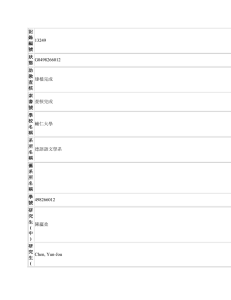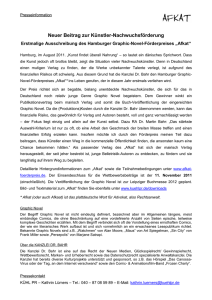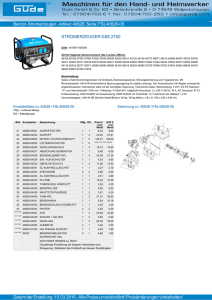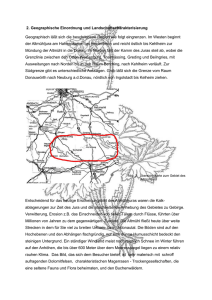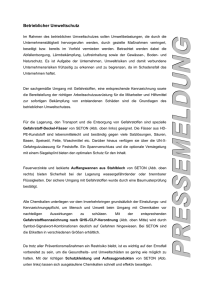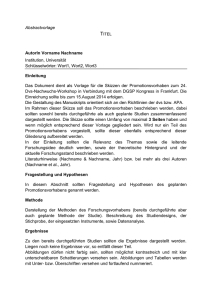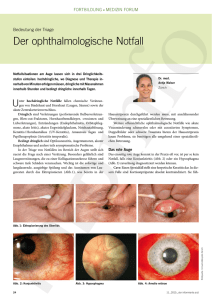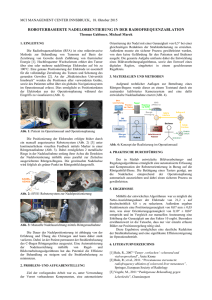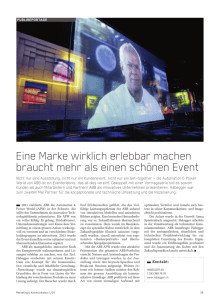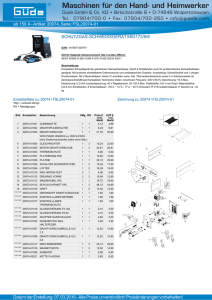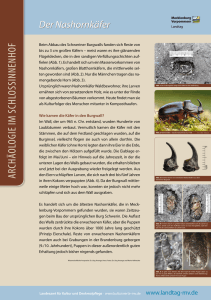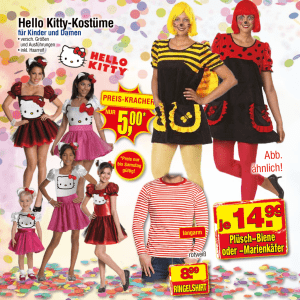記 錄 編 號 13249 狀 態 G0498266012 助 教 查 核 建檔完成 索 書 號
Werbung
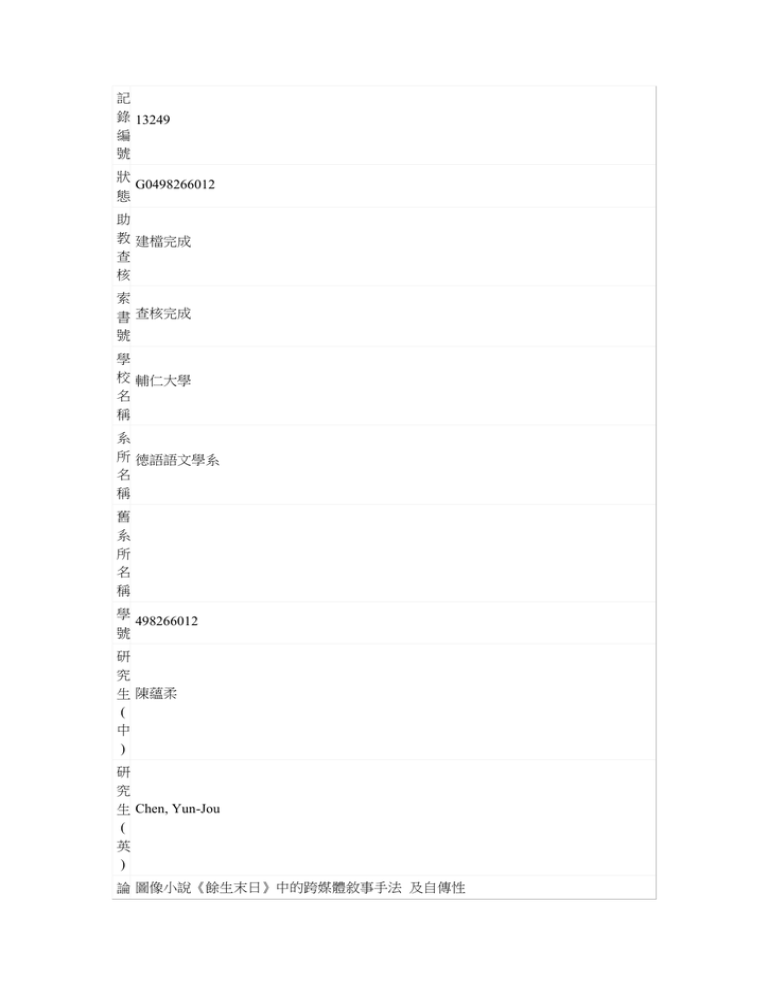
記 錄 13249 編 號 狀 G0498266012 態 助 教 建檔完成 查 核 索 書 查核完成 號 學 校 輔仁大學 名 稱 系 所 德語語文學系 名 稱 舊 系 所 名 稱 學 498266012 號 研 究 生 陳蘊柔 ( 中 ) 研 究 生 Chen, Yun-Jou ( 英 ) 論 圖像小說《餘生末日》中的跨媒體敘事手法 及自傳性 文 名 稱 ( 中 ) 論 文 名 Transmedia storytelling techniques and autobiography in the graphic novel Today is 稱 The Last Day of the Rest of Your Life ( 英 ) 其 他 Transmediale Erzähltechniken und Autobiographie in der Graphic Novel Heute ist der 題 letzte Tag vom Rest deines Lebens 名 指 導 教 何靜 授 ( 中 ) 指 導 教 Brigitte Höhenrieder 授 ( 英 ) 校 內 全 文 2013.6.26 開 放 日 期 校 外 2013.6.26 全 文 開 放 日 期 全 文 不 開 放 理 由 電 子 全 文 同意 送 交 國 圖 . 國 圖 全 文 2013.6.26 開 放 日 期 . 檔 案 封面 摘要 目次及論文全文 參考文獻 說 明 電 子 01 02 03 04 全 文 學 位 碩士 類 別 畢 業 101 學 年 度 出 版 102 年 語 文 別 關 鍵 字 自傳 虛構性 漫畫 情緒上的真實 親密性 圖像小說 跨媒體敘事手法 ( 中 ) 關 鍵 Autobiography transmedia storytelling techniques Fiktionality emotional truth Intimacy 字 ( Graphic Novel 英 ) 摘 要 ( 中 ) 本論文以自傳圖像小說的跨媒體敘事手法分析德語第一本自傳圖像小說《餘 生末日》。自傳圖像小說所含跨媒體敘事手法:文字方框、對話框及圖像, 呈現不同於一般自傳書寫所內含的基本問題。此外,自傳內容或是取材史實 對於圖像小說成為一個新的漫畫概念有著重大的影響,而自傳也因漫畫媒體 的加入, 增添了敘事的多樣性,影響自傳本身所含的(作者與讀者、作者與 文本、讀者與文本)親密性。 此研究首先將釐清圖像小說的特徵及區分其概 念本身的問題。包括:圖像小說的出版形式、主題的選擇、漫畫歷史演變對 於圖像小說的意義。然後整理自傳的定義及本身的基本問題:虛構性、真實 性及親密性。 在《餘生末日》中,自傳內容也因跨媒體敘事手法的加入,有 著特殊的「情緒上的真實性」。本論文以敘事手法中的幾種層面來分析自傳 內容及「親密性」的呈現: 1)圖與文:表現出各式各樣的「我」,從敘述方 框、對話框、至繪畫出來的,如自畫像般的「我」。此外,手寫文字的呈現 可產生一種如閱讀別人日記的效果,史料則可作為一種「證據」。這些對於 自傳中的親密性、情緒上的真實有著影響。 2)時間層面:漫畫框的大小、長 寬及形式都影響著敘述時間及故事時間。如:較小的繪畫框加上在中間描繪 緊密連續的動作可用來描寫緊湊緊張的情節。或者,波浪式的漫畫框加上圖 像,能暗示時間的回溯或是停滯。另一方面,方框文字中第一人稱敘述者能 展現確切的時間,對於情節的時間作出詳細的交代。 3)空間層面:圖像小說 中,故事發生地點一方面透過敘事涵文字,如:街牌、地圖標明。一方面透 過作者描繪重要的景點,來暗示角色們所在的位置,如:羅馬的各地景點。 此外,作者使用許多不同的視角來描繪故事的情節。如:主角、其他角色與 旁觀者的視角切換,造成角色「對看」的效果。透過各種不同視角來描繪主 角,但這些視角也提供了作者如何將自己客觀化,由他人的眼光來看主角, 也就是過去的自己。 作者使用以上所提到的圖像小說敘事手法造就出了作者 和讀者間高度的親密性,實現了自傳中情緒上、譬喻上的真實。 摘 要 ( 英 ) 論 文 目 次 In this paper, I will analyze the transmedia storytelling techniques in the first German autobiographical Graphic Novel Heute ist der letzte Tag vom Rest deines Lebens by Ulli Lust. The transmedia narrative techniques: text and image bring the basic problem of autobiography to another level, which involves the “truth claim”, authentication and intimacy between the author, the reader and the main figure. In addition, autobiographical or documentary content have crucial influences for the controversial concept “Graphic Novel”. In order to analyze the special techniques in autobiographical Graphic Novel Heute ist der letzte Tag vom Rest deines Lebens, there are three main questions, that I try to answer: 1) what is autobiographical graphic novel, and what kind of characteristics it processes? 2) what kind of transmedia storytelling techniques are there in comics? 3) how these techniques used in Heute ist der letzte Tag vom Rest deines Lebens? How the artist Ulli uses her style and narrative skills to create the intimacy in her autobiography? To answer these questions, first of all, I will clarify the concept and basic problem of graphic novel and autobiography in chapter 2. Then I will list the distinctive features of autobiographical graphic novel that were often mentioned in other researches so far. In chapter 3 to chapter 4 I will introduce the transmedia storytelling techniques, especially the effect from text and image, time and space in Graphic Novel, which have more fluencies of the intimacy in autobiography, and analyze them in Heute ist der letzte Tag vom Rest deines Lebens. Inhaltsverzeichnis 1. Einleitung 4 1.1 Themenstellung und Aufbau der Arbeit 4 1.2 Vorgehensweise und Quellenlage 6 1.3 Zur Autorin Ulli Lust und ihren Werken 8 2. Die autobiographische Graphic Novel 10 2.1 Roman und Graphic Novel 10 2.1.1 Umfang und Publikationsformen der Graphic Novel 11 2.1.2 Themen: Erwachsene als Adressaten? 12 2.1.3 Literarische Bedeutung 15 2.1.4 Darstellungsformen der Graphic Novel: Grafische Mittel des Comics 18 2.2 Autobiographie und autobiographische Graphic Novel 20 2.2.1 Das Problem der Authentizität in der Autobiographie 21 2.2.2 „Intimität“: Authentizität und Fiktionalität in der autobiographischen Graphic Novel 24 a) Offene Fiktionalität als „ironic authentication“ 26 b) „The cartoon self“ 27 c) Privates Bekenntnis und Handschrift 29 d) Autobiographische Intimität durch Themenwahl: Sex, Trauma und Feminismus 30 2.2.3 Die Bedeutung der autobiographischen Graphic Novel 34 2.3 Heute ist der letzte Tag vom Rest deines Lebens als Autobiographie 35 3. Transmediale Erzähltechniken in Comics 38 3.1 TextBild-Beziehung 38 3.1.1 Rezeptionsaspekte 38 3.1.2 Beeinflussung durch den Entstehungsprozess 43 3.2 Wirkung von Bild und Text 45 3.2.1 Text in Comics 45 3.2.2 Bilder in Comics 52 a) Basiseinheit Panel 52 b) Grafischer Stil von Bildern 53 3.2.3 Interaktion zwischen Bild und Text in Comics: Typographie 57 3.3 Intimität von Text und Bild in Heute ist der letzte Tag vom Rest deines Lebens 59 3.3.1 Das „Ich“ im Text 60 3.3.2 Das gezeichnete „Ich” 69 3.3.3 Handschrift und Dokumentation 77 4. Zeitdimension 85 4.1 Die Darstellung der Erzählzeit und der erzählten Zeit 86 4.1.1 Das Einzelpanel 87 4.1.2 Die Panelsequenz 93 4.2 Erzählte Zeit: Historie und Erinnerung in Comics 97 4.2.1 Die erzählte Zeit in der historischen Geschichte 97 4.2.2 Darstellung der Erinnerung 98 4.3 Zeitdimension in Heute ist der letzte Tag vom Rest deines Lebens 99 4.3.1 Erzählte Zeit und Erzählzeit 99 4.3.2 Anordnung der Panels und Zeitdauer 104 5. Die Raumdimension 109 5.1 Die Rahmen von Panels 110 5.2 Die Perspektive 111 5.2.1 Ein-, Zwei- und DreifluchtpunktPerspektive 111 5.2.2 Der Wechsel der Perspektiven 113 5.3 Raum und Körper 115 5.4 Raumdimension in Heute ist der letzte Tag vom Rest deines Lebens 116 5.4.1 Orte und Raumdarstellung 116 5.4.2 Der Perspektivenwechsel 120 6. Schluss 126 Primärliteratur: 127 Sekundärliteratur: 129 參 考 文 獻 Primärliteratur: Lust, Ulli: Heute ist der letzte Tag vom Rest deines Lebens, Berlin: Avantverlag, 2009. Andere Comics: Bäder, Peter/ Barandun, Claudio/ Basler, David/ Fischbacher, Roli/ Gasser, Christian/ Luginbühl, Anja/ Meier, Fredy/ Meiler, Herbert/ Pitterle, Pierre/ Rickenbach, Kati/ Schuler, Christoph/ Siebenländer, Angelika/ Thommen, Babs/ Witkowski, Sabine/ Zimmermann, Joe (Hr.): Strapazin: erotische Geschichte, Nr. 98, Schweiz: Strapazin, 2010. Bäder, Peter/ Barandun, Claudio/ Basler, David/ Fischbacher, Roli/ Gasser, Christian/ Luginbühl, Anja/ Meier, Fredy/ Meiler, Herbert/ Pitterle, Pierre/ Rickenbach, Kati/ Schuler, Christoph/ Siebenländer, Angelika/ Thommen, Babs/ Zimmermann, Joe (Hr.): Strapazin: Damenstammtisch, Nr. 106, Schweiz: Strapazin, 2012. Crumb, Robert: „The Many Faces of R. Crumb“, in: The Complete Crumb Comics: R. Crumb versus The Sisterhood, Vol. 9, Seattle: Fatagraphics Books, 1992. ―: The Book of Mr. Natural, Seattle: Fantagraphics, 2010. Dinter, Tim/ Hander, Jens/ Käppel, Kathi/ Lust, Ulli/ Pfeiffer, Kai/ Witzel, Markus Mawil: Alltagsspionage – Comicreportagen aus Berlin, Berin: Monogatari, 2001. Eisner, Will: A Contract with God, USA: W. W. Norton & Company, 2006. Green, Justin: Binky Brown’s Sampler, San Francisco: Last Gasp, 1995. Kanter, Albert Lewis: Classics Illustrated, NY: Elliot Publishing Co., 1941-1942/ NY: Gilberton Company 1942-1967/ LA: 1967-1971. Lust, Ulli: Springpoem 1-5, Berlin: Monogatari, 1998-2004. ―: Fashionvictims, Trendverächter, Berlin: Avant-verlag, 2008. Miller, Frank/ Janson, Klaus: Batman: The Dark Knight Returns, USA: DC Comics, 2011. Moore, Alan: Watchmen, USA: DC Comics, 2011. Pekar, Harvey: Best of American Splendor, NY: Ballantine Books, 2005. Satrapi, Marjane: Persepolis, Volum 3, Hong Kong: Joint Publishing, 2005. Spiegelman, Art: Raw 2, USA: Penguin, 1990. ―: Maus II. A Survivor’s Tale and Here My Troubles began, USA: Pantheon, 1991. ―: The Complete Maus CD-ROM - A Survivor’s Tale- Part 1. My Father Bleeds History Part II From Maus, Almonte: Voyageur Pub, 1999. Ware, Chris: Jimmy Corrigan: The Smartest Kid on Earth, NY: Pantheon Books, 2000. Witzel, Markus: Wir können ja Freunde bleiben, Berlin: Reprodukt, 2003. Schriftliche Primärliteratur: Declaude, Thomas/ Schneider, Ulrike: Ein Stück Himmelblau, Innsbruck: Tyrolia, 1998. Hofbauer, Friedl/ Recheis, Käthe/ Schneider, Ulrike: Marco und Drache. Nach einem rumänischen Volksmärchen, Berlin: Kinderbuchverlag, 1993. Kästner, Erich: Als ich ein kleiner Junge war, München: Deutscher Taschenbuch Verlag, 16. Aufl., 2012. Lessing, G. E.: Laokoon: Oder: Über die Grenzen der Malerei und Poesie, Stuttgart: Reclam, 1964. Spiegelman, Art: “Symptoms of Disorder/ Signs of Genius”, in: Green, Justin: Binky Brown’s Sampler, San Francisco: Last Gasp, 1995, S. 4-6. Sekundärliteratur: Abbott, Lawrence L.: “Comics art: Characteristics and Potentialities of a Narrative Medium”, in: Journal of Popular Culture 19.4, 1986, S. 155-176. Adam, Jeff: Documentary Graphic Novels and Social Realism, Bern: Peter Lang, 2008. Adams, Timothy Dow: Telling Lies in Modern American Autobiography, Chapel Hill: the University of North Carolina Press, 1990. Arnold, Heinz Ludwig (Hr.): Text+Kritik. Sonderband Comics, Mangas, Graphic Novels, München: Richard Boorberg Verlag, 2009. Baetens, Jan (Hr.): The Graphic Novel, Belgian: Leuven University Press, 2001. Balzer, Jens/ tom Dieck, Martin: „Nicht versöhnt: Bild und Texte im Comic“, in: Schreibheft, Zeitschrift für Literatur (51), 1998, S. 47-50. Beaty, Bart: “Autobiography as Authenticity“, in: Heer, Jeet / Worcester, Kent (Hr.): A Comics Studies Reader, University Press of Mississippi, 2009, S. 226-235. Bergson, Henri: Materie und Gedächtnis. Eine Abhandlung über die Beziehung zwischen Körper und Geist, Hamburg: Meiner, 1991. Bruss, Elizabeth W.: “Eye for I: Making and Unmaking Autobiography in Film”, in: Olney, James (Hr.): Autobiography: Essays Theoretical and Critical, New Jersey: Princeton University Press, S. 296-320. Carrier, David: The Aesthetics of Comics, Pennsylvania: Pennsylvania State University Press, 2000. Chaney, Michael A.: “Introduction”, in: Chaney, Michael A. (Hr.): Graphic Subjects: Critical Essays on Autobiography and Graphic Novels, London: The University of Wisconsin Press, 2011, S. 3-9. Chute, Hillary: „’The Shadow of a Past Time’: History and Graphic Representation in Maus.“, in: Twentieth Century Literature 52.2, 2006, S. 199-230. ―: “Comics as Literature? Reading Graphic Narrative”, in: PMLA 123.2, 2008, S. 452-465. ―: Graphic Women: Life Narrative and Contemporary Comics (Gender and Culture Series), NY: Columbia University Press, 2010. Dammann, Günther: „Temporale Strukturen des Erzählens im Comic“, in: Hein, Michael/ Hüners, Michael/ Michaelsen, Torsten (Hr.): Ästhetik der Comics , S. 91-101. Deleuze, Grilles: Cinema 2: The Time-Image, Minneapolis: the Athlone Press, 1989. (Orig.: Cinéma 2, L’Image-temps, Paris: Les Editions de Munuit, 1985) Dittmar, Jakob F.: Comic-Analyse, Konstanz: UVK, 2008. Eco, Umberto: Einführung in die Semiotik, Stuttgart: UTB, 2002. Eisner, Will: Comics and Sequential Art. Principles and Practices from the Legendary Cartoonist, New York/ London: W. W. Norton & Company, 2008. ―: Graphic Storytelling and Visual Narrative, New York/ London: W. W. Norton & Company, 2008. Etter, Lukas/ Hoppeler, Stephanie/ Rippl, Gabrielle: „Intermedialitäten in Comics. Neil Gaimans The Sandman“, in: Ditschke, Stephan/ Kroucheva, Katerina/ Stein, Daniel: Comics. Zur Geschichte und Theorie eines populärkulturellen Mediums, Bielefeld: Transcirpt Verlag, 2009, S. 53-80. Ewert, Jeanne C.: „Comics and Graphic Novel“, in: Herman, David/ John, Manfred/ Ryan, Marie-Laure (Hr.): Routledge Encyclopedia of Narrative Theory, London: Routledge, S. 72. Gardner, Jared: “Autography’s Biography, 1972-2007”, in: Biography 31.1, Winter 2008, S. 1-26. Gilmore, Leigh: The Limits of Autobiography: Trauma and Testimony, Ithaca/New York: Cornell University Press, 2001. Groensteen, Thierry: “Ein erster Blumenstrauß von Zwängen. Die Spielregeln des OuBaPo”, in: Schreibheft, Zeitschrift für Literatur (51), 1998, S. 182-202. Grünewald, Dietrich: Comics, Tübingen: Niemeyer, 2000. Gunn, Janet Varner: Autobiography: Towards a Poetics of Experience, Philadelphia: University of Pennsylvania, 1982. Holdenried, Michaela: Autobiographie, Stuttgart: Reclam, 2000. Hatfield, Charles: Alternative Comics: An Emerging Literature, Jackson: University Press of Mississippi, 2005. Harvey, C. Robert: The Art of the Comic Book. An Aesthetic History, Jackson: University Press of Mississippi, 1996. Horn, Maurice: The World Encyclopedia of Comics, New York: Chelsea House, 1990. Kröplien, Manfred: Werbegraphik – Denkmethode oder Artistik? Zur Grundlegung der Typographie, Stuttgart: Nadolski, 1968. Laplanche, Jean: Life and Death in Psychoanalysis, Baltimore: Johns Hopkins University Press, 1976. Lejeune, Philippe: On Autobiography, Minneapolis: University of Minnesota Press, 1989. Mahne, Nicole: Transmediale Erzähltheorie: Eine Einführung, Göttingen: Vandenhoeck & Ruprecht, 2007. Martin, Wallace: Recent Theories of Narrative, Ithaca/New York: Cornell University Press, 1986. McCloud, Scott: Understanding Comics: The Invisible Art, New York: Harper Collins Books, 1994. Miething, Christoph: Saint-Sartre oder der autobiographische Gott, Heidelberg: Studia Romanioca 47, 1983. Misch, Georg: “Begriff und Ursprung der Autobiographie (1907/1949)”, in: Niggl, Günter (Hr.): Die Autobiographie. Zu Form und Geschichte einer literarischen Gattung, Darmstadt: Wissenschaftliche Buchgesellschaft, 1989, S. 33-55. Mitchell, W. J. T.: Picture Theory, Chicago/London: The University of Chicago Press, 1994. Platthaus, Andreas: „Comics. Meine italienische Geisterfahrt“, in: Frankfurter Allgemeine Zeitung, 15. September, 2009. Peirce, Charles Sanders: “A Sketch of Logical Critics”, in: Peirce Edition Project (Hr.): The Essential Peirce. Selected Philosophical Writings. Vol. 2 (1893-1913), Bloomington/ Indianapolis: Indiana University Press, 1998. Panofsky, Erwin: Aufsätze zu Grundfragen der Kunstwissenschaft, Berlin: Wissenschaftsverlag Spiess, 1980. Pratt, Henry John: „Narrative in Comics”, in: The Journal of Aesthetics and Art Criticism 67.1, 2009, S.107-117. Redlin, Jane/ Schühle, Judith (Hr.): Comic Leben. Comic Life, Bielefeld/Berlin: Kerber Verlag, 2012. Renza, Louis: “Review of Educated Lives: The Rise of Modern Autobiography in America by Thomas Cooley”, in: American Literary Realism 10, 1977, S. 317-320. Rosenkranz, Patrick: Rebel Visions: The Underground Comix Revolution, 1963-1975, Seattle: Fantagraphics, 2002. Ruhrberg, Karl: Kunst des 20. Jahrhunderts. Bd. 1 Malerei, Köln: Taschen, 2005. Jay, Paul: Being in the Text: Self-representation from Wordsworth to Roland Barthes, Ithaca/ New York: Cornell University Press, 1984. Sabin, Roger: Adult Comics: An Introduction, London/New York: Routledge, 2003. Salisbury, Mark: “Frank Miller”, in: Artists on Comic Art, London: Titan Books, 2002, S. 163-183. Schacter, Daniel L.: Searching for Memory. The Brain, the Mind, and the Past, New York: Basic Books, 1996. Schäffner, Alex M.: „Kunst im Comic“, in: Czerwionka, Marcus/ Langhans, Heiko (Hr.): Lexikon der Comics, Meitingen: Corian-Verlag, 1991, S. 6. Schmid, Wolf: Der Textaufbau in den Erzählungen Dostoevskijs, München: John Benjamins Pub Co., 1973. Schnackertz, Hermann Josef: Form und Funktion medialen Erzählens. Narrativität in Bildsequenz und Comicstrip, München: Fink, Wilhelm 1980. Schüwer, Martin: „Erzählen in Comics. Bausteine einer Plurimedialen Erzähltheorie“, in: Vera u. Ansgar, Nünning (Hr.): Erzähltheorie transgenerisch, intermedial, interdisziplinär, Trier: WVT, 2002, S. 185-216. ―: Wie Comics erzählen: Grundriss einer intermedialen Erzähltheorie der grafischen Literatur, Trier: WVT Wissenschaftlicher Verlag, 2008. Shapiro, Stephen A.: „The Dark Continent of Literature: Autobiography.“, in: Comparative Literature Studies 5, 1968, S. 421-454. Sontag, Susan: Über Fotographie: Essays, Frankfurt am Main: Fischer Verlag, 1980. (Orig.: On Photography, London: Penguin, 1977) Stanzel, Franz K.: Theorie des Erzählens, Göttingen: Vandenhoeck & Ruprecht, 1995. Stocker, Karl: „Comics: eine Verbindung von Zeichensystemen. Ein Plädoyer gegen Pauschal-Urteile“, in: Verweyen, Annemarie (Hr.): Comics. Eine Ausstellung im Rheinischen Freilichtmuseum Landesmuseum für Volkskunde Kommern, Köln: Rheinland-Verlag, 1986, S. 51-63. Tebben, Karin: Literarische Intimität: Subjektkonstitution und Erzählstruktur in autobiographischen Texten von Frauen, Tübingen und Basel: A. Francke Verlag, 1997. Vice, Sue: “’It’s about time’: The Chronotope of the Holocaust in Art Spiegelman’s Maus”, in: Baetens, Jan (Hr.), The Graphic Novel, Belgian: Leuven University Press, 2001, S. 47-60. Internet: http://www.believermag.com/issues/200704/?read=interview_mccloud (09. November 2012) http://www.graphic-novel.info/ (15. Oktober 2012) http://www.electrocomics.com/info.htm (18. Dezember 2012) http://www.oed.com/view/Entry/244747 (10. Januar 2012) http://blather.net/articles/amoore/northampton.html (26. November 2011) http://www.schriftarten-fonts.de/c/35/asiatische_schriften (18. September 2012) Abbildungsverzeichnis: Abb. 1, Abbott 1986, 157. Abb. 2, McCloud 1994, 31: 4. Abb. 3, McCloud 1994, 51: 1. Abb. 4, http://www.schriftartenfonts.de/c/35/asiatische_schriften (18. September 2012) Abb. 5, Lust: 88:7-9. Abb. 6, Lust: 102:1-4. Abb. 7, Lust: 284. Abb. 8, Lust: 196. Abb. 9, Lust: Titelblatt Abb. 10, Lust: 176:9-11. Abb. 11, Lust: 247:1-6. Abb. 12, Lust: 247 Abb. 13, Lust: 275 Abb. 14, Lust: 278:9 Abb. 15, Lust: 105:3 Abb. 16, Lust: 283:4 Abb. 17, Lust: 5 Abb. 18, Lust: 457 Abb. 19, Lust: 404:1-3 Abb. 20, Ein Kind läuft über den Balkon, Giacomo Balla, 1912 http://www.wikipaintings.org/en/giacomo-balla/girl-running-on-a-balcony-1912 (25. April 2013) Abb. 21, Satrapi 2005 [2002]: 20 (Persepolis 3) Abb. 22, Satrapi 2005 [2002]: 45 (Persepolis 3) Abb. 23, Satrapi 2005 [2002]: 40 (Persepolis 3) Abb. 24, McCloud 1994: 71 Abb. 25, McCloud 1994: 71 Abb. 26, Lust: 40:1-2 Abb. 27, Lust: 69:5 Abb. 28, Lust: 251:3-8 Abb. 29, Lust: 193: 3-5 Abb. 30, Lust: 311: 7-10 Abb. 31, Lust: 173:1 Abb. 32, Lust: 384: 1-4 Abb. 33, Lust: 224: 2-4 Abb. 34, Lust: 383: 2-11 Abb. 35, Lust: 430: 1-4 Abb. 36, Wong: http://www.appledaily.com.tw/appledaily/article/supplement/20100405/32410858/%E8 %80%81%E5%A4%AB%E5%AD%90%E6%90%B6%E9%8F%A1%E9%A0%AD (05. April 2010) Abb. 37, Lust: 95:1 Abb. 38, Lust: 138 Abb. 39, Lust: 131 Abb. 40, Lust: 132 Abb. 41, Lust: 91:5 Abb. 42, Lust: 4-7 Abb. 43, Lust: 192 論 文 136 頁 數 附 註 全 文 點 0000002 閱 次 數 資 料 建 2013/6/14 置 時 間 轉 檔 2013/06/27 日 期 全 文 檔 存 取 記 錄 異 動 記 錄 498266012 2013.6.26 18:13 36.225.147.107 new 01 498266012 2013.6.26 18:20 36.225.147.107 new 01 498266012 2013.6.26 18:20 36.225.147.107 new 02 498266012 2013.6.27 12:12 140.136.208.175 del 01 498266012 2013.6.27 12:12 140.136.208.175 del 02 498266012 2013.6.27 12:15 140.136.208.175 new 01 498266012 2013.6.27 12:15 140.136.208.175 new 02 498266012 2013.6.27 12:15 140.136.208.175 new 03 498266012 2013.6.27 12:18 140.136.208.175 new 04 030540 2013.6.27 13:44 140.136.208.64 del 02 030540 2013.6.27 13:44 140.136.208.64 del 03 030540 2013.6.27 13:44 140.136.208.64 del 04 030540 2013.6.27 13:44 140.136.208.64 new 02 030540 2013.6.27 13:44 140.136.208.64 new 03 030540 2013.6.27 13:44 140.136.208.64 new 04 C 498266012 Y2013.M6.D14 17:23 36.225.147.78 M 498266012 Y2013.M6.D14 17:23 36.225.147.78 M 498266012 Y2013.M6.D26 18:07 36.225.147.107 M 498266012 Y2013.M6.D26 18:08 36.225.147.107 M germ2571 Y2013.M6.D26 18:26 36.225.147.107 M 498266012 Y2013.M6.D26 18:27 36.225.147.107 M germ2571 Y2013.M6.D27 9:27 140.136.213.2 M germ2571 Y2013.M6.D27 9:27 140.136.213.2 M 030540 Y2013.M6.D27 10:12 140.136.208.64 M 030540 Y2013.M6.D27 10:13 140.136.208.64 M 498266012 Y2013.M6.D27 12:20 140.136.208.175 M 498266012 Y2013.M6.D27 12:20 140.136.208.175 M 498266012 Y2013.M6.D27 12:21 140.136.208.175 M 030540 Y2013.M6.D27 13:44 140.136.208.64 M 030540 Y2013.M6.D27 13:44 140.136.208.64 I 030540 Y2013.M6.D27 13:46 140.136.208.64
